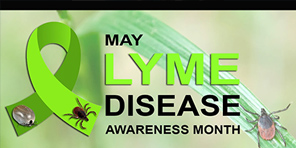CHICAGO – With weather warming up, the Illinois Department of Public Health (IDPH) is urging the public to get educated about how to protect themselves from ticks and Lyme disease – an infection that sickens an estimated 500,000 people each year in the United States – at the start of National Lyme Disease Awareness Month.
“Lyme disease is an infection that individuals can get from the bite of infected ticks – and it is the most common vector-borne illness in the United States with more than 500,000 people diagnosed and treated each year,” said IDPH Director Dr. Sameer Vohra. “With tick season beginning here in Illinois, I encourage our residents to learn how you can Fight the Bite and protect yourself and your loved ones from tickborne illnesses. If you do find yourself with Lyme disease symptoms – fever, fatigue, headache, and a circular rash – see your health care provider immediately to prevent serious illness.”
IDPH has created a fact sheet and Tick Defense Knowledge Check crossword puzzle that make it fun to learn about how to protect yourself and your loved ones from tickborne illnesses.
Director Vohra said the most important thing people can do to “Fight the Bite” is to diligently check themselves, their pets, and children for ticks after spending time in areas where ticks live, such as in and near wooded areas, tall grass, and brush. Removing ticks within a 24-hour period reduces the risk of potential disease transmission.
In addition to Lyme disease, other serious tickborne diseases include Rocky Mountain Spotted Fever, Tularemia, Ehrlichiosis, and Babesiosis. Some tickborne illnesses can be life threatening. Rocky Mountain Spotted Fever is particularly dangerous and may cause death as quickly as five days after symptom onset.
If you become ill with fever and/or rash after being in an area where ticks may have been, contact your health care provider immediately.
IDPH has teamed up with the with the Illinois Natural History Survey to create an interactive Tick Surveillance Map that documents the counties in Illinois where the different tick species have been confirmed as well as the diseases they may carry.
State public health officials note that Illinoisans who are travelling out of state should be aware that there is a much higher prevalence of Lyme disease in certain geographic areas, including Wisconsin, Minnesota and parts of Michigan, and across the northeastern United States.
Following are additional tips for how to avoid tickborne illnesses and have a healthy time in the outdoors:
Walk in the center of trails. Avoid wooded, bushy areas with high grass and leaf litter.
Wear light-colored clothing to make ticks easier to find. Tuck long pants into socks and boots.
Apply an EPA-registered insect repellent containing 20% DEET, picaridin, IR3535, or Oil of Lemon Eucalyptus according to label directions. The EPA has a search tool that can help you find the product that best suits your needs.
Conduct full-body tick checks on family members (underarms, ears, belly button, behind knees, between legs, waist, hair and scalp) every two to three hours. Also check any gear or pets taken on outings.
Put your clothes in the dryer on high for 10 minutes (or one hour for damp clothes) to kill ticks.
Bathe or shower within two hours after coming indoors.
If you find a black legged tick on you that may have been attached for more than three days, then seek medical attention to decide if you need an antibiotic to prevent Lyme disease.
It is often helpful to keep the tick for species identification. Place the tick in rubbing alcohol or in a sealed bag/container to bring to your healthcare provider or local health department for submission to IDPH. A submission form can be found on HERE on the IDPH website.
If you are a clinician, click HERE for more information about Lyme Disease and click HERE for more information about Rocky Mountain Spotted Fever

